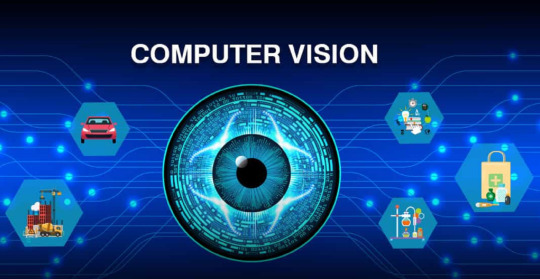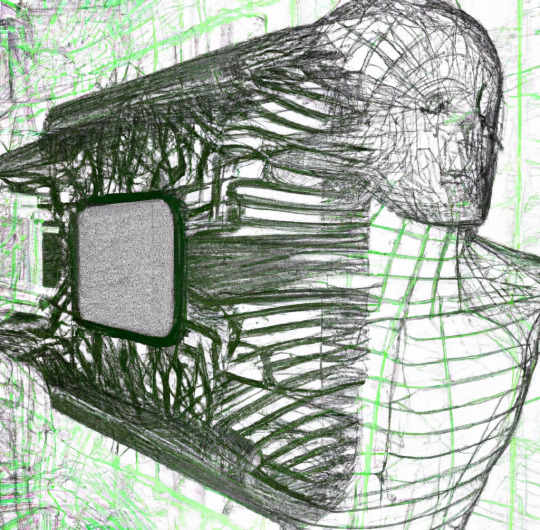#Vision AI technology
Explore tagged Tumblr posts
Text
InovarTech – Pioneering the Future with Vision AI Technology
InovarTech, we specialize in delivering intelligent Vision AI solutions that redefine operational efficiency, product quality, and workplace safety across industries. Our innovative AI vision technology combines the power of computer vision with deep learning to offer a versatile and scalable Vision AI platform tailored to your unique business challenges.
From high-precision defect detection on production lines to advanced safety compliance and inventory tracking, our AI vision solutions are engineered to deliver real-time insights and automation. Whether you're in manufacturing, logistics, or retail, our technology helps you unlock new levels of performance.
With our custom-built Vision AI solution, organizations can gain competitive advantages through smarter decision-making, reduced operational risks, and enhanced customer satisfaction.
What We Offer:
End-to-end AI vision technology implementation
Scalable Vision platform AI integrations
24/7 visual inspection and defect detection
Safety monitoring and compliance automation
Industry-specific computer vision solutions
Experience the power of vision with InovarTech — where AI meets action.
#Vision ai solutions#Vision ai technology#Ai vision technology#Vision platform ai#Ai vision solutions
0 notes
Text
How Vision AI is Personalizing the Customer Experience
In today’s rapidly evolving digital landscape, customer experience has become a crucial differentiator for businesses. Traditional methods of personalization, such as targeted emails and tailored product recommendations, are now standard practice. However, the advent of Vision AI (Artificial Intelligence) is transforming how businesses interact with customers, offering unprecedented levels of personalization and engagement. Vision AI, which involves the use of machine learning and computer vision to interpret and understand visual data, is enabling businesses to create highly individualized experiences that cater to the unique preferences and behaviors of each customer.
Understanding Vision AI
Vision AI refers to technologies that enable machines to gain high-level understanding from digital images or videos. It encompasses various techniques such as image recognition, object detection, facial recognition, and scene interpretation. By mimicking human vision, Vision AI can analyze visual data in real time, making it a powerful tool for personalizing the customer experience across multiple industries.
Enhancing Retail Experiences
One of the most significant applications of Vision AI in retail is in creating immersive and personalized shopping experiences. Traditional retail has been revolutionized by e-commerce, but Vision AI is bridging the gap between online and offline shopping by offering enhanced customer experiences.
Personalized In-Store Assistance
Vision AI-powered cameras and sensors can track customer movements and behaviors in real time. By analyzing this data, stores can offer personalized assistance and recommendations. For instance, when a customer spends a significant amount of time in a particular section, Vision AI can alert store associates to offer help or suggest related products, enhancing the shopping experience.
Smart Mirrors and Virtual Try-Ons
Smart mirrors equipped with Vision AI allow customers to virtually try on clothes and accessories. These mirrors use augmented reality (AR) to overlay products onto the customer’s reflection, providing a personalized fitting experience without the need for physical trials. This technology not only improves customer satisfaction but also reduces return rates, as customers can make more informed purchasing decisions.
Customer Behavior Analysis
Vision AI can analyze customer behavior patterns to offer personalized promotions and discounts. By understanding which products customers frequently interact with or purchase, retailers can tailor their marketing strategies to individual preferences. This level of personalization can significantly boost customer loyalty and increase sales.

Revolutionizing Online Shopping
E-commerce platforms are leveraging Vision AI to provide highly personalized and engaging online shopping experiences. The ability to analyze visual content in real-time enables online retailers to understand and predict customer preferences more accurately than ever before.
Visual Search
Traditional text-based searches can sometimes be limiting for customers who are unsure how to describe what they are looking for. Vision AI enables visual search functionality, allowing customers to upload images of desired products and find similar items instantly. This feature not only enhances the user experience but also increases the likelihood of conversion by making the search process more intuitive and efficient.
Personalized Recommendations
Vision AI can analyze customers’ visual preferences based on their browsing history and interactions with images and videos. By understanding color preferences, style choices, and visual aesthetics, AI can offer highly personalized product recommendations. For example, if a customer frequently browses floral patterns, the AI can prioritize showing them products that match this preference.
Dynamic Content Customization
E-commerce platforms can use Vision AI to dynamically customize content for each user. By analyzing visual data and user behavior, websites can display personalized banners, advertisements, and product suggestions. This ensures that each customer has a unique and relevant shopping experience, increasing engagement and conversion rates.
Transforming Customer Service
Vision AI is also revolutionizing customer service by enabling more efficient and personalized interactions. The ability to analyze visual data in real-time can significantly enhance the quality of customer support and improve overall satisfaction.
Facial Recognition for Personalized Interactions
Facial recognition technology can identify customers and retrieve their purchase history, preferences, and previous interactions with the brand. This allows customer service representatives to offer highly personalized assistance, addressing the customer by name and providing relevant information quickly. Such personalized interactions can enhance the customer’s perception of the brand and foster loyalty.
Visual Customer Support
Vision AI can be used to provide visual customer support, enabling customers to share images or videos of issues they are facing. Support agents can then analyze this visual data to diagnose problems and offer precise solutions. For example, if a customer is having trouble assembling a product, they can share a video of the issue, and the AI can guide them through the steps to resolve it. This reduces resolution times and improves the overall customer experience.
Automated Support with Visual Data
Chatbots and virtual assistants equipped with Vision AI can handle customer queries that involve visual data. For instance, customers can upload images of damaged products, and the AI can assess the damage and process returns or replacements automatically. This level of automation streamlines customer service processes and ensures quick and efficient resolutions.
Elevating the Entertainment Industry
The entertainment industry is another sector where Vision AI is making significant strides in personalizing the customer experience. By analyzing visual data from videos and images, AI can offer tailored content recommendations and enhance user engagement.
Personalized Content Recommendations
Streaming platforms use Vision AI to analyze viewers’ watching habits and preferences. By understanding the visual elements that resonate with each user, such as genre, actors, and cinematography, AI can recommend personalized content. This not only enhances the viewing experience but also keeps users engaged by continuously offering relevant and appealing suggestions.
Interactive and Immersive Experiences
Vision AI is also enabling more interactive and immersive experiences in entertainment. For example, augmented reality (AR) and virtual reality (VR) applications use computer vision to create personalized and engaging experiences. Users can interact with virtual environments tailored to their preferences, making entertainment more immersive and enjoyable.
Enhancing Social Media Engagement
Social media platforms leverage Vision AI to analyze user-generated content and interactions. By understanding the visual preferences and behaviors of users, these platforms can personalize content feeds, advertisements, and recommendations. This ensures that users see content that is most relevant and engaging to them, enhancing their overall experience on the platform.
Improving Healthcare Services
In the healthcare sector, Vision AI is transforming patient care by offering personalized medical services and improving diagnostic accuracy. The ability to analyze visual data in real-time is enabling healthcare providers to deliver more precise and tailored treatments.
Personalized Treatment Plans
Vision AI can analyze medical images such as X-rays, MRIs, and CT scans to identify specific conditions and recommend personalized treatment plans. By comparing visual data from numerous patients, AI can identify patterns and suggest the most effective treatments for individual patients. This level of personalization can significantly improve patient outcomes.
Remote Patient Monitoring
Vision AI is also enhancing remote patient monitoring by analyzing visual data from wearable devices and home monitoring systems. This technology can detect changes in a patient’s condition in real-time and alert healthcare providers to take immediate action. Personalized alerts and recommendations ensure that patients receive timely and appropriate care, even from a distance.
Enhancing Telemedicine
Telemedicine services are benefiting from Vision AI’s ability to analyze visual data during virtual consultations. Doctors can use AI-powered tools to examine patients remotely, ensuring accurate diagnoses and personalized treatment recommendations. This improves the quality of care and makes healthcare more accessible to a broader population.
Conclusion
Vision AI is revolutionizing the way businesses personalize the customer experience across various industries. By leveraging the power of visual data, companies can create highly individualized and engaging interactions that cater to the unique preferences and behaviors of each customer. From retail and e-commerce to customer service, entertainment, and healthcare, Vision AI is enabling businesses to offer more relevant, efficient, and satisfying experiences. As this technology continues to evolve, its potential to transform the customer experience and drive business success will only grow, making it an essential tool for any forward-thinking organization.
Source: https://inferencelabs.blogspot.com/2024/06/how-vision-ai-personalizing-customer-experience.html
#Compute Vision#Customer experience#Inference Labs#Vision AI#Vision AI technology#Visual data analysis#Visual search
0 notes
Text
occasionally if christopher doesn't know how to (or doesn't want to) do his homework, he'll use ai. one night, eddie walks into the room to check on him and looks at his computer and absolutely loses his shit because "that's not natural. turn that off!" its not even necessarily the fact that chris is using it to cheat that bothers him. no, eddie just hates the entire concept of ai.
and christopher, like the teenager he is, is having none of it and is like "it's helping me do my homework, dad." and eddie pulls out like 30 statistics about how ai is NOT helpful, which then evolves into a 10 minute long rant/lecture. "you need help? I will help you! that won't help you!"
he eventually finishes it off by saying this is a "ai free household" and chris "needs to learn to do it by himself" and then he takes the laptop and shuts it like a bitchy main character from a 2000s movie would shut a flip phone.
#technophobe eddie diaz my beloved.#hed go into google and aggressively groan at the gemini ai search result. i can feel that in my bones#he's so real actually#i too am afraid of technology#are you seeing the vision#i just know that man hates chat gpt#911#911 abc#eddie diaz#christopher diaz
22 notes
·
View notes
Text
#reel#dystopian society#dystopian#augmented reality#apple vision pro#apple#apple vision#futuristic#ai#artificial intelligence#future of social media#future#tech#technology
9 notes
·
View notes
Text
Tom and Robotic Mouse | @futuretiative
Tom's job security takes a hit with the arrival of a new, robotic mouse catcher.
TomAndJerry #AIJobLoss #CartoonHumor #ClassicAnimation #RobotMouse #ArtificialIntelligence #CatAndMouse #TechTakesOver #FunnyCartoons #TomTheCat
Keywords: Tom and Jerry, cartoon, animation, cat, mouse, robot, artificial intelligence, job loss, humor, classic, Machine Learning Deep Learning Natural Language Processing (NLP) Generative AI AI Chatbots AI Ethics Computer Vision Robotics AI Applications Neural Networks
Tom was the first guy who lost his job because of AI
(and what you can do instead)
⤵
"AI took my job" isn't a story anymore.
It's reality.
But here's the plot twist:
While Tom was complaining,
others were adapting.
The math is simple:
➝ AI isn't slowing down
➝ Skills gap is widening
➝ Opportunities are multiplying
Here's the truth:
The future doesn't care about your comfort zone.
It rewards those who embrace change and innovate.
Stop viewing AI as your replacement.
Start seeing it as your rocket fuel.
Because in 2025:
➝ Learners will lead
➝ Adapters will advance
➝ Complainers will vanish
The choice?
It's always been yours.
It goes even further - now AI has been trained to create consistent.
//
Repost this ⇄
//
Follow me for daily posts on emerging tech and growth
#ai#artificialintelligence#innovation#tech#technology#aitools#machinelearning#automation#techreview#education#meme#Tom and Jerry#cartoon#animation#cat#mouse#robot#artificial intelligence#job loss#humor#classic#Machine Learning#Deep Learning#Natural Language Processing (NLP)#Generative AI#AI Chatbots#AI Ethics#Computer Vision#Robotics#AI Applications
4 notes
·
View notes
Text

CAPTCHAs tech companies exploiting free labor to train AI vision for defense contractors military drones and autonomous weapons
#CAPTCHAs tech companies exploiting free labor to train AI vision for defense contractors military drones and autonomous weapons#captchas#tech companies#technology#tech#companies#fuck corporations#exploitation#exploitative#free labor#free labour#ai generated#ai art#ai artwork#ai girl#ai#a.i. generated#a.i. art#a.i.#artificial intelligence#military#army#navy#air force#fuck the military#anti military#military industrial complex#adf#adfa#australiandefenceforce
14 notes
·
View notes
Text
Shaping a Sustainable Future by Advancing ESG Goals
U3Core application of DigitalU3 redefines how organizations approach Environmental, Social, and Governance (ESG) strategies by combining real-time data, advanced analytics, and AI-powered automation
Email us at: [email protected]
youtube
#Smart Cities#Green Future#Sustainable operations#Technology for Sustainability#Asset Management#Digital Transformation#Computer Vision#AI for Sustainability#IoT for Sustainability#Youtube#intel
3 notes
·
View notes
Text
Elon Musk’s Ally Pushes for ‘AI-First’ Strategy in Government Agency
Elon Musk’s Ally Pushes for ‘AI-First’ Strategy in Government Agency In a groundbreaking statement, a close ally of Elon Musk has revealed that embracing an “AI-first” approach is the future for a key government agency. This bold vision outlines how artificial intelligence (AI) will shape the operations and policies of government entities, especially those tied to technology and national…
#AI adoption#AI collaboration#AI in defense#AI in government#AI strategy#AI technology#AI-driven government#AI-first#artificial intelligence#cybersecurity#data analysis#Elon Musk#future of AI#government agency#government reform#Musk&039;s vision#national security#public sector#public services#tech industry#technology innovation
3 notes
·
View notes
Text
Like a Prayer Battle Royale version from Deadpool but it’s Calla and Anton killing people together in the games
#chloe gong#immortal longings#vilest things#calla tuoleimi#anton makusa#please see my vision I have no art skill#I don’t want ai I want the technology to make edits with the images in my brain#making fan edits with words on a page
4 notes
·
View notes
Text
#Tags:Advanced AI Systems#Apple Vision Pro#Biometric Authentication#Biometric Innovations#Civil Liberties and Technology#Consumer Technology#Corporate Control#Data Security Risks#facts#Iris Recognition Technology#life#New World Order#Optic ID#Podcast#Privacy Concerns#serious#straight forward#Surveillance Technology#truth#upfront#Post navigation#Previous
2 notes
·
View notes
Text

Week in Review
October 23rd-29th
Welcome to Fragile Practice, where I attempt to make something of value out of stuff I have to read.
My future plan is to do longer-form original pieces on interesting topics or trends. For now, I'm going to make the weekly reviews habitual and see if I have any time left.

Technology
OpenAI forms team to study ‘catastrophic’ AI risks, including nuclear threats - Tech Crunch; Kyle Wiggers
OpenAI launched a new research team called AI Safety and Security to investigate the potential harms of artificial intelligence focused on AI alignment, AI robustness, AI governance, and AI ethics.
Note: Same energy as “cigarette company funds medical research into smoking risks”.
Artists Allege Meta’s AI Data Deletion Request Process Is a ‘Fake PR Stunt’ - Wired; Kate Knibbs
Artists who participated in Meta’s Artificial Intelligence Artist Residency Program accused the company of failing to honor their data deletion requests and claim that Meta used their personal data to train its AI models without their consent.
Note: Someday we will stop being surprised that corporate activities without obvious profit motive are all fake PR stunts.
GM and Honda ditch plan to build cheaper electric vehicles - The Verge; Andrew J. Hawkins
General Motors and Honda cancel their joint venture to develop and produce cheaper electric vehicles for the US market, citing the chip shortage, rising costs of battery materials, and the changing market conditions.
Note: What are the odds this isn’t related to the 7 billion dollars the US government announced to create hydrogen hubs.
'AI divide' across the US leaves economists concerned - The Register; Thomas Claburn
A new study by economists from Harvard University and MIT reveals a significant gap in AI adoption and innovation across different regions in the US.
The study finds that AI usage is highest in California's Silicon Valley and the San Francisco Bay Area, but was also noted in Nashville, San Antonio, Las Vegas, New Orleans, San Diego, and Tampa, as well as Riverside, Louisville, Columbus, Austin, and Atlanta.
Nvidia to Challenge Intel With Arm-Based Processors for PCs - Bloomberg; Ian King
Nvidia is using Arm technology to develop CPUs that would challenge Intel processors in PCs, and which could go on sale as soon as 2025.
Note: I am far from an NVIDIA fan, but I’m stoked for any amount of new competition in the CPU space.
New tool lets artists fight AI image bots by hiding corrupt data in plain sight - Engadget; Sarah Fielding
A team at the University of Chicago created Nightshade, a tool that lets artists fight AI image bots by adding undetectable pixels into an image that can alter how a machine-learning model produces content and what that finished product looks like.
Nightshade is intended to protect artists work and has been tested on both Stable Diffusion and an in-house AI built by the researchers.
IBM's NorthPole chip runs AI-based image recognition 22 times faster than current chips - Tech Xplore; Bob Yirka
NorthPole combines the processing module and the data it uses in a two-dimensional array of memory blocks and interconnected CPUs, and is reportedly inspired by the human brain.
NorthPole can currently only run specialized AI processes and not training processes or large language models, but the researchers plan to test connecting multiple chips together to overcome this limitation.
Apple’s $130 Thunderbolt 4 cable could be worth it, as seen in X-ray CT scans - Ars Technica; Kevin Purdy
Note: These scans are super cool. And make me feel somewhat better about insisting on quality cables. A+.

The Shifting Web
On-by-default video calls come to X, disable to retain your sanity - The Register; Brandon Vigliarolo
Video and audio calling is limited to anyone you follow or who is in your address book, if you granted X permission to comb through it.
Calling other users also requires that they’ve sent at least one direct message to you before.
Only premium users can place calls, but everyone can receive them.
Google Search Boss Says Company Invests to Avoid Becoming ‘Roadkill’ - The New York Times; Nico Grant
Google’s senior vice president overseeing search said that he sees a world of threats that could humble his company at any moment.
Google Maps is getting new AI-powered search updates, an enhanced navigation interface and more - Tech Crunch; Aisha Malik
Note: These AI recommender systems are going to be incredibly valuable advertising space. It is interesting that Apple decided to compete with Google in maps but not in basic search, but has so far not placed ads in the search results.
Reddit finally takes its API war where it belongs: to AI companies - Ars Technica; Scharon Harding
Reddit met with generative AI companies to negotiate a deal for being paid for its data, and may block crawlers if no deal is made soon.
Note: Google searches for info on Reddit often seem more effective than searching Reddit itself. If they are unable to make a deal, and Reddit follows through, it will be a legitimate loss for discoverability but also an incredibly interesting experiment to see what Reddit is like without Google.
Bandcamp’s Entire Union Bargaining Team Was Laid Off - 404 Media; Emanuel Maiberg
Bandcamp’s new owner (Songtradr) offered jobs to just half of existing employees, with cuts disproportionately hitting union leaders. Every member of the union’s eight-person bargaining team was laid off, and 40 of the union's 67 members lost their jobs.
Songtradr spokesperson Lindsay Nahmiache claimed that the firm didn’t have access to union membership information.
Note: This just sucks. Bandcamp is rad, and it’s hard to imagine it continuing to be rad after this. I wonder if Epic had ideas for BC that didn’t work out.

Surveillance & Digital Privacy
Mozilla Launches Annual Digital Privacy 'Creep-o-Meter'. This Year's Status: 'Very Creepy' - Slashdot
Mozilla gave the current state of digital privacy a 75.6/100, with 100 being the creepiest.
They measured security features, data collection, and data sharing practices of over 500 gadgets, apps, and cars to come up with their score.
Every car Mozilla tested failed to meet their privacy and security standards.
Note: It would be great if even one auto brand would take privacy seriously.
EPIC Testifies in Support of Massachusetts Data Privacy and Protection Act -Electronic Privacy Information Center (EPIC)
Massachusetts version of ADPPA.
Note: While it may warm my dead heart to see any online privacy protections in law, scrambling to do so in response to generative AI is unlikely to protect Americans in any meaningful way from the surveillance driven form of capitalism we’ve all been living under for decades.
Complex Spy Platform StripedFly Bites 1M Victims - Dark Reading
StripedFly is a complex platform disguised as a cryptominer and evaded detection for six years by using a custom version of EternalBlue exploit, a built-in Tor network tunnel, and trusted services like GitLab, GitHub, and Bitbucket to communicate with C2 servers and update its functionality.
iPhones have been exposing your unique MAC despite Apple's promises otherwise - Ars Technica
A privacy feature which claimed to hide the Wi-Fi MAC address of iOS devices when joining a network was broken since iOS 14, and was finally patched in 17.1, released on Wednesday.
Note: I imagine this bug was reported a while ago, but wasn’t publically reported until the fix was released as a term of apple’s bug bounty program.
What the !#@% is a Passkey? - Electronic Frontier Foundation
Note: I welcome our passkey overlords.
#surveillance#tech#technology#news#ai#generative ai#machine vision#electric vehicles#evs#hydrogen#futurism#Apple#iphone#twitter#bandcamp#labor unions#digital privacy#data privacy#espionage#passkeys
11 notes
·
View notes
Text
Chief Technology Officer
Job title: Chief Technology Officer Company: Leonardo Job description: Job Description: Your Impact We are looking for a Chief Technology Officer for RF Systems to join our Radar… marketplace. What you will do as a Chief Technology Officer for RF Systems: To define and monitor the progress of the… Expected salary: Location: Edinburgh Job date: Sun, 29 Jun 2025 02:09:42 GMT Apply for the job now!
#Aerospace#agritech#Android#Automotive#Backend#Chief Technology Officer (CTO)#computer-vision#CRM#CTO#data-privacy#edtech#erp#ethical AI#game-dev#healthtech#HPC#Java#Machine learning#Networking#NFT#product-management#Python#remote-jobs#rpa#Salesforce#sharepoint#site-reliability#software-development#solutions-architecture
0 notes
Text
VisionGuard AI: Revolutionizing Production Defect Detection
In today’s competitive manufacturing landscape, production defects can spell disaster. Enter VisionGuard AI, a cutting-edge computer vision AI platform engineered for AI-powered defect detection. This robust vision AI solution combines AI video analysis and computer vision in AI automation to identify anomalies in real time—whether it’s a misaligned part, a surface blemish, or a faulty seal.
VisionGuard AI leverages a cloud-based application development approach to ensure seamless scalability and integration with existing ai vision systems. With high-resolution AI vision cameras, it captures thousands of images per minute. These are processed using deep learning models fine-tuned for each production line. Unlike manual inspections—prone to fatigue and inconsistency—VisionGuard AI maintains 24/7 vigilance.
The computer vision AI application supports multi-angle analysis for complex assemblies, while vision AI for manufacturing ensures that every unit meets specification. And when a defect is detected, it automatically flags the item for review or removal, reducing waste and rework.
What sets VisionGuard AI apart is its modular design. Companies can select from an array of vision AI solutions—from basic flaw detection to full-system integration with PLCs, ERP, or other MES systems. Whether it’s bottling inspection with vision AI to detect underfills, cap misplacement, or label errors, or manufacturing vision AI solutions geared toward electronics, automotive, or food production, the platform delivers.
With AI-powered visual inspection, manufacturers gain actionable insights into defect trends—spotting root causes like misfeeds or tool wear. And thanks to computer vision AI system analytics, continuous improvement initiatives are grounded in data.
Key benefits include:
Dramatically lower defect rates
Reduced downtime through early fault detection
Lower costs via less waste and fewer recalls
Improved compliance with quality standards
By integrating VisionGuard AI, manufacturers embrace the future—one where computer vision AI solutions empower consistent quality and operational excellence. The journey begins with installing smart ai vision cameras at critical points, feeding data into the computer vision AI platform, and deploying inline alerts. From pilot lines to full-scale deployment, VisionGuard AI transforms quality assurance into a competitive advantage.
#agentic ai copilot#agentic ai for service#agentic ai in sales#agentic ai solutions#ai vision system#agentic ai services#agentic ai solution#agentic technology in service#vision ai solutions#vision ai systems
1 note
·
View note
Text
Oh, this whole AI art business is really going places. Look at this baeutiful arrt!
A Willy Wonka pop-up event in Glasgow had attendees calling the police after they paid £35 and the event didn’t deliver what was promised.
Event goers were promised a whimsical adventure all themed around something Willy Wonka might create in his factory.





Source
The keen-eyed amongst you might have noticed something a little bit…wrong.
Imagnation Lab. Encherining Entertainment. Catgacating. Live perforrmances. Cartchy tunes. Exarserdray lollipops. And my favourite “A pasadise of sweets teats”
But what did the event actually look like? WELL.
Feel like the marketing team got a bit carried away.



#seriously#i don’t hate technology I just don’t understand why everyone is jumping on this bandwagon#what’s the story here why do we need this#what’s the long term vision for ai#because I don’t fucking see it#humans#ai#scotland#willy got wonked
49K notes
·
View notes
Text
Discover how early AI training can help preserve identity in dementia patients by becoming a bridge between the conscious mind and subconscious habits. A Resilient Philosopher reflection.
#AI#Alzheimer’s#artificial intelligence#caregiving#dementia#digital self#early intervention#identity#leadership#memory loss#mental health#neuroplasticity#subconscious#technology and memory#The Resilient Philosopher#Vision LEON
0 notes
Text
Discover how early AI training can help preserve identity in dementia patients by becoming a bridge between the conscious mind and subconscious habits. A Resilient Philosopher reflection.
#AI#Alzheimer’s#artificial intelligence#caregiving#dementia#digital self#early intervention#identity#leadership#memory loss#mental health#neuroplasticity#subconscious#technology and memory#The Resilient Philosopher#Vision LEON
0 notes